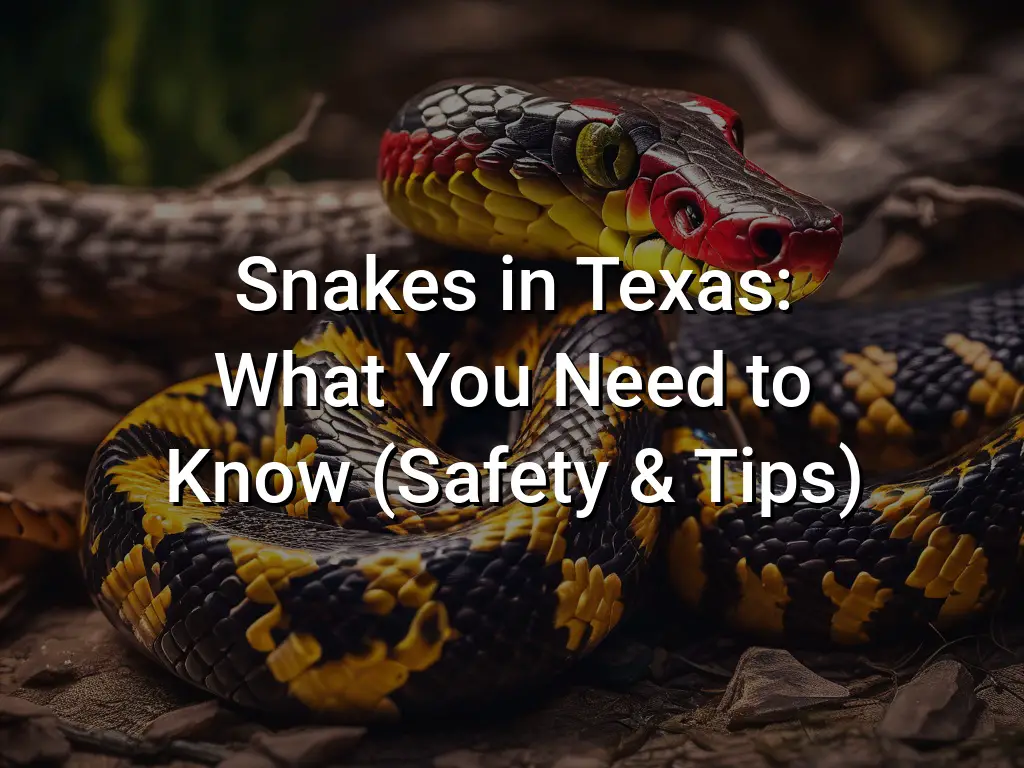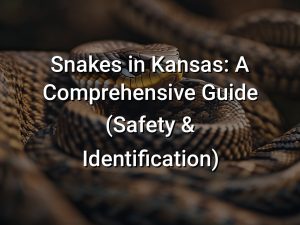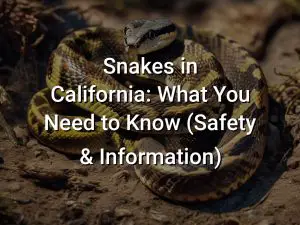Snakes in Texas: What You Need to Know (Safety & Tips)

Snakes in Texas: just the mention of these slithery creatures can evoke a range of emotions. Whether you have a fascination for these reptiles or a fear that sends shivers down your spine, it’s important to know the facts. In this article, we’ll uncover everything you need to know about snakes in Texas, including safety tips, identification of venomous and non-venomous snakes, and how to handle encounters with these fascinating creatures.
Texas is home to a wide variety of snake species, each with its own unique characteristics and behaviors. From venomous snakes that require caution and respect to non-venomous snakes that contribute to a balanced ecosystem, we’ll delve into the world of Texas snakes. So, whether you’re a curious adventurer or simply want to stay safe in snake country, join us as we explore the fascinating world of snakes in Texas.
Quick Links
Different Types of Snakes in Texas
Texas is home to a diverse range of snake species, both venomous and non-venomous. It’s important to familiarize yourself with the different types of snakes you may encounter to ensure your safety and understand their behavior.
One of the most common venomous snakes in Texas is the Western Diamondback Rattlesnake. Recognized by its distinctive diamond-shaped markings and rattling tail, this snake can be found in a variety of habitats across the state.
The Copperhead is another venomous snake found in Texas. It has a copper-colored head and dark, cross-banded patterns on its body. Copperheads are usually found in wooded areas, rocky slopes, and near water sources.
The Coral Snake is one of the most venomous snakes in Texas. It has colorful bands of red, yellow, and black, and can be found in forested areas, especially near streams and rivers.
While venomous snakes require caution, it’s essential to remember that the majority of snakes in Texas are non-venomous and play a crucial role in the ecosystem. Some common non-venomous snakes you may encounter include the Rat Snake, Bullsnake, and Garter Snake.
It’s important to respect all snakes and give them space. Avoid approaching or provoking them, and always be aware of your surroundings when hiking or exploring areas where snakes may be present.
Identification and Characteristics of Venomous Snakes in Texas
In Texas, there are several species of venomous snakes that residents should be aware of for their own safety. It is important to be able to identify these snakes and understand their characteristics to avoid potential encounters and bites.
One venomous snake commonly found in Texas is the Western Diamondback Rattlesnake (Crotalus atrox). It is a large and heavy-bodied snake, typically measuring between 3 and 4 feet long, although some can grow up to 7 feet. It has distinct diamond-shaped patterns along its back with alternating light and dark colors. The Western Diamondback Rattlesnake has a triangular-shaped head and a rattle at the end of its tail, which it uses as a warning sign when threatened.
The Copperhead (Agkistrodon contortrix) is another venomous snake found in Texas. It is a medium-sized snake, averaging between 2 and 3 feet long. The Copperhead has a distinctive copper-colored head with a dark, hourglass-shaped pattern on its body. Its body color can vary from light tan to reddish-brown. Unlike rattlesnakes, Copperheads do not have rattles and rely on their camouflage to avoid detection.
The Cottonmouth, also known as the Water Moccasin (Agkistrodon piscivorus), is a venomous snake commonly found in or near bodies of water in Texas. It is a stout and robust snake, typically measuring between 2 and 4 feet long. The Cottonmouth has a dark-colored body with pale bands or crossbands. Its head is blocky and distinct from its body, and it has a white lining inside its mouth, which is where it gets its name. Cottonmouths are often aggressive and will display their open mouth as a warning sign.
The Coral Snake (Micrurus fulvius) is the most venomous snake found in Texas. It is a small and slender snake, usually measuring between 2 and 3 feet long. The Coral Snake has bright and distinctive coloration, with alternating bands of black, yellow, and red. It is important to remember the rhyme “Red touches yellow, kill a fellow” to distinguish the Coral Snake from non-venomous snakes with similar color patterns.
When encountering a venomous snake in Texas, it is crucial to avoid approaching, touching, or attempting to handle the snake. It is recommended to give the snake a wide berth and allow it to move away naturally. Additionally, it is important to be aware of your surroundings, especially when hiking or spending time in areas known to have venomous snakes.
Common Non-Venomous Snakes in Texas
While Texas is home to several venomous snake species, there are also many non-venomous snakes that you might come across in the state. It’s important to be able to identify these snakes to alleviate any unnecessary concern. Here are some common non-venomous snakes you may encounter in Texas:
- Rat Snake: Rat snakes are large and robust snakes that come in various colors and patterns. They are excellent climbers and are known for their ability to control rodent populations.
- Corn Snake: Corn snakes are medium-sized snakes with vibrant colors. They are often found near human habitats as they are excellent at controlling rodent populations.
- Gopher Snake: Gopher snakes are known for their resemblance to rattlesnakes. They have similar color patterns, but lack rattles. These snakes play a crucial role in controlling rodent populations.
- Coachwhip Snake: Coachwhip snakes are highly active and fast-moving snakes. They are known for their slender bodies and red or brown coloration.
- King Snake: King snakes are known for their striking black and yellow or black and white color patterns. They are powerful constrictors and prey on venomous snakes.
- Ribbon Snake: Ribbon snakes are slender and have distinct longitudinal stripes running along their bodies. They are often found near water and feed on small fish and amphibians.
Encountering a non-venomous snake can be an opportunity to appreciate the natural diversity in Texas. Remember to observe snakes from a safe distance and avoid disturbing them or attempting to handle them unless you have proper training and experience.
Safety Tips for Dealing with Snakes
Snakes can be found in various parts of Texas, and it’s important to know how to safely handle encounters with them. Here are some safety tips:
- Stay calm: If you come across a snake, try to remain calm and avoid sudden movements. Snakes are more likely to strike if they feel threatened or cornered.
- Keep your distance: It’s important to maintain a safe distance from snakes. Do not attempt to touch or handle them, even if they appear to be non-venomous.
- Wear protective clothing: When venturing into snake-prone areas, wear long pants, boots, and thick socks to reduce the risk of snakebites.
- Watch where you step: Be mindful of your surroundings, especially when walking through tall grass, brush, or rocky areas. Snakes may be hiding in these areas.
- Use a snake hook or long stick: If you need to move a snake, use a snake hook or a long stick to gently guide it away from your immediate vicinity.
- Don’t provoke or harass snakes: Do not try to provoke, harass, or kill snakes. This increases the risk of being bitten and can have negative effects on snake populations and ecosystems.
- Teach children about snake safety: Educate children about snake safety and the importance of not approaching or touching snakes without adult supervision.
- Consult a professional: If you have a snake on your property or in your home, it’s best to contact a professional snake handler or wildlife removal service for safe and humane removal.
By following these safety tips, you can minimize the risk of snake encounters and ensure your own safety and the safety of the snakes.
What to Do If You Encounter a Snake
Encountering a snake can be a frightening experience, but it’s important to stay calm and take appropriate actions to ensure your safety and the snake’s well-being. Here are some guidelines to follow if you encounter a snake:
- Stay calm and try to keep a safe distance from the snake. Remember that most snakes are not venomous and will not attack unless provoked.
- Do not attempt to touch, handle, or corner the snake. Sudden movements or aggression can provoke the snake and increase the risk of a bite.
- If you are near the snake, slowly and carefully back away, giving it space to retreat.
- Keep an eye on the snake’s movements and direction while maintaining a safe distance. This information will be helpful for identifying the snake later, if necessary.
- If the snake is in a high-traffic area or poses immediate danger to people or pets, contact a professional snake removal service for assistance.
- Avoid using any form of snake repellent or deterrent, as they are generally ineffective and can be harmful to the environment.
- If you are bitten by a snake, seek medical attention immediately. Do not attempt to suck out the venom, apply a tourniquet, or use any other traditional methods as they are not effective and can worsen the situation.
Remember, snakes play a vital role in the ecosystem and should not be harmed or killed unless absolutely necessary. It’s important to respect and coexist with these creatures while taking necessary precautions to ensure your safety.
Preventing Snakes in Your Home and Yard
Snakes can occasionally find their way into homes and yards, but there are steps you can take to prevent them from entering your living space:
- Seal any cracks or crevices in the foundation of your home.
- Install door sweeps on all exterior doors.
- Repair any damaged screens on windows and vents.
- Keep your yard clean and tidy, removing any piles of debris or clutter where snakes could hide.
- Trim back overgrown vegetation and regularly mow your lawn.
- Keep firewood and other piles of materials elevated and away from your home.
- Avoid attracting prey species, such as rodents or birds, by securing trash cans and bird feeders.
- Consider installing snake-proof fencing around your property if snakes are a persistent problem in your area.
By implementing these preventative measures, you can significantly reduce the likelihood of snakes taking up residence in your home or yard.
Snakebite First Aid
If you or someone you know has been bitten by a snake, it is important to act quickly and seek medical attention. Follow these steps for snakebite first aid:
- Stay calm and try to keep the affected area still. This will help slow down the spread of venom.
- Remove any tight clothing, jewelry, or constrictive items near the bite site, as swelling may occur.
- Wash the bite gently with soap and water to help reduce the risk of infection.
- Keep the bitten area at or below heart level to slow down the spread of venom.
- Do not apply a tourniquet or try to suck out the venom. These methods have been proven to be ineffective and can cause further harm.
- Do not use ice or apply a cold compress directly to the bite. This can constrict blood vessels and potentially worsen the effects of the venom.
- Do not try to capture or kill the snake. Instead, try to remember its size, color, and any distinctive markings to help medical professionals identify the species.
- Seek immediate medical attention. Call 911 or go to the nearest emergency room.
- Follow the instructions given by healthcare professionals. They may administer antivenom or provide additional treatment based on the severity of the bite.
Remember, snakebite first aid is not a substitute for professional medical care. It is crucial to seek medical attention as soon as possible after a snakebite to receive proper treatment.
Snake Handling and Removal
Handling and removing snakes can be dangerous and should only be done by trained professionals. It is important to remember that snakes are wild animals and should be treated with caution and respect.
If you encounter a snake on your property or in your home, it is best to call a professional snake removal service. They have the knowledge and experience to safely capture and remove the snake without causing harm to you or the snake. Attempting to handle a snake on your own can increase the risk of snakebite and injury.
When calling a snake removal service, provide them with as much information as possible about the snake, such as its size, color, and location. This information can help them determine the appropriate equipment and techniques to use for safe removal.
While waiting for professional help to arrive, it is important to keep a safe distance from the snake. Do not try to kill or capture the snake yourself, as this can agitate the snake and increase the risk of a bite.
It is also important to take preventative measures to minimize the likelihood of snakes entering your home or property. Seal any gaps or holes in your foundation and walls, trim vegetation and remove debris from your yard, and keep your living areas clean and clutter-free.
Remember, snakes play an important role in the ecosystem and should be respected and protected. Avoid killing snakes unnecessarily and instead focus on preventing encounters and seeking professional help when necessary.
Snake Repellents and Deterrents
When it comes to dealing with snakes in Texas, prevention is key. While there is no foolproof method to keep snakes away, there are some repellents and deterrents you can use to reduce the likelihood of encountering them:
- Natural Snake Repellents: Certain plants, such as marigolds, lemongrass, and wormwood, are said to repel snakes due to their strong scents. Planting these around your yard or garden may help deter snakes from entering.
- Commercial Snake Repellents: There are various snake repellent products available in the market. These products often contain chemical substances that emit strong odors snakes dislike. Follow the product instructions carefully when using them.
- Sealing Entry Points: Snakes can enter your home through small gaps and cracks. Seal any openings in your foundation, walls, windows, and doors to prevent snakes from sneaking in.
- Keep Your Yard Clean: Snakes are attracted to cluttered areas, so keep your yard clean and free of debris. Trim overgrown vegetation and remove any potential hiding spots, such as woodpiles or tall grass.
- Snake Fencing: Installing snake-proof fencing around your property can be an effective way to keep snakes out. Make sure the fence extends underground to prevent snakes from burrowing underneath.
- Professional Help: If you have a persistent snake problem or want to take extra precautions, consider seeking help from professional snake removal services.
Remember, snakes play an important role in the ecosystem and are generally not aggressive unless provoked. It’s essential to respect their presence while taking necessary measures to ensure your safety.
Conclusion
Living in Texas means sharing the land with various snakes, both venomous and non-venomous. It’s important to be aware of the different types of snakes you may encounter and take necessary precautions to ensure your safety.
By following the safety tips provided, such as wearing protective clothing and footwear, staying cautious in snake habitats, and knowing how to react when encountering a snake, you can greatly reduce the risks associated with snake encounters. Additionally, taking steps to snake-proof your home and yard can help prevent these reptiles from entering your living space.
Remember, if you or someone you know is bitten by a snake, it is vital to seek immediate medical attention and follow proper snakebite first aid procedures. And for snake handling and removal, it’s always best to leave it to trained professionals to ensure both your safety and the snake’s well-being.
With the right knowledge and precautions, you can coexist with snakes in Texas and enjoy the outdoors with peace of mind.







